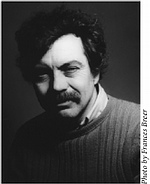Bob Breer
Bob Breer (1926-2011), artist, filmmaker and pioneer of avant-garde animation died on August 11, in his home in Tucson where he was living with his wife Kate Flax.
Bob was a resident of Palisades for many years, while married to his first wife, Frances Foote from 1955 to 1982. There were the years in Paris, and the 60’s and 70’s in New york City, exhilarating times! The children of this marriage are Sophia Breer (Minneapolis), Julia Breer (Closter, NJ) Emily Breer (Garrison, NY) and Sabelle Breer Frasca (Palisades, NY). A fifth daughter, Sally Breer, from Bob’s second marriage, lives in Los Angeles, CA. As notices pour in from all over the world, the daughters are learning about the public side of their father’s life and his place in the history of animation.
Bob was the son of Barbara Zeder and Carl Breer, an automotive engineer and inventor who designed the Airflow for Chrysler in Detroit, Michigan. Bob attended Stanford as an engineering student but switched to figurative painting and finally converted to abstraction after seeing paintings by Mondrian on a school trip.
In 1949 he sailed to France, exhibited at the Denise Rene Gallery and turned out large abstract paintings and flipbooks which eventually led to stop-action short films like Form Phase IV, Image par Images and Recreation, during the 1950’s while living in Paris. Viewers were bombarded, as quoted in the August 18th 2011 New York Times obituary, “with wiggling lines, letters, abstract shapes and live-action images that jumped and flashed, zoomed and receded, appeared and disappeared,” inflicting what Bob once called, “assault and battery on the retina.”
Returning to New York in 1959, he became one of the underground filmmakers along with Stan Brakhage, Kenneth Anger, Stan Vanderbeek, Jonas Mekas, and Andy Warhol, and participated in the ‘happenings’ of Pop artists during the 60’s. He and Claes Oldenburg made a film ‘Pat’s Birthday’ (1962), that was photographed down at the Snedens Landing waterfall. Bob later turned to moving (s-l-o-w-l-y) sculptures, large and small, called ‘floats’ and began his teaching career in 1971 at Cooper Union in the film department where he remained for thirty years.
A retrospective of Bob’s career is on exhibit until September 25, 2011 at the Baltic Center for Contempory Art in Gateshead England. In October there will be a retrospective of his art (paintings, flipbooks, films, and sculptures) at the Tinguely Museum in Basel, Switzerland in a tribute to his contribution to animation and art history.
Jonas Mekas, in a 1971 interview, quoted Bob as saying, “In all my work, I tried to amaze myself with something, and the only way you can amaze yourself is to create a situation in which an accident can happen.” Some personal reflections by an ex-wife: Bob Breer was a very witty man. At a party there was often a group around him laughing, and I often joined them. I am now living in the barn on Ludlow Lane that used to be his studio while we were married. It had sculptures, hoses, machines and a real toy car from Bob’s childhood that worked. He was always working and liked having a place next door to go to in case he had an idea at night. In fact, if you were sitting talking to him (with a drink in hand) he was really working in his head while carrying on a conversation. Selective conversation.
He was generous to a fault, never denying my need for the house in Paris, the house on Block Island and the home we shared on Washington Spring Road next to the Presbyterian manse across from the Palisades church which he later sold to Harry and Dorothy Davis for what he paid for it years before, in order to allow them to stay in the community. I can’t imagine anyone doing that now!
In Paris when we were having our first baby I told him that Wagner had composed the Siegfried Idyll for the birth of his first child and asked Bob what he was going to do. The result was one of his most popular films, A Man and His Dog Out for Air (1957), a whimsical film using black line drawing.
In sum, I enjoyed living with a dedicated artist, being on the scene, making supper for someone who was ‘breaking new ground.’ After our divorce, I took up painting, drawing and sculpture, to see what I could do, always mindful of his low tolerance for “bad art.”


